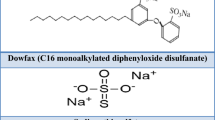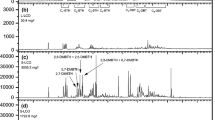Abstract
Biodesulfurization (BDS) is a promising method to remove sulfur compounds from diesel and gasoline. However, the information on BDS of heavy oil is scanty, which might be due to their “undesirable” physical properties and more complicated sulfur diversities. In this study, the BDS of one kind of heavy oil, bunker oil MFO380 was investigated. The biocatalyst was obtained by the enrichment with oil sludge as the seed and using dibenzothiophene (DBT) as the sole sulfur source. The enriched biocatalyst (microbial mixed culture) could selectively remove sulfur from DBT and DBT was transformed into 2-hydroxybiphenyl, which indicates that the BDS process is beneficial to non-destructive carbon bonds and thus can maintain the calorific value. The bunker oil BDS results showed that after 7 days of incubation, the removal efficiency of sulfur in MFO380 was only 2.88 %, but this could be significantly improved by adding surfactants Triton X-100 or Tween 20. This effect could be attributed to greatly reduced viscosity of heavy oil and increased mass transfer of sulfur compounds in heavy oil into water. Adding Triton X-100 achieved the highest removal efficiency of sulfur, up to 51.7 % after 7 days of incubation. The optimal amount of Triton X-100 was 0.5 g/50 ml medium. When toluene was added as an organic solvent for MFO380, the BDS activity was improved, while lower than the effect of adding surfactants.





Similar content being viewed by others
References
Alboudwarej H, Felix J, Taylor S (2006) Highlighting heavy oil. Oilfield Rev 18(2):34–53
Bhatia S, Sharma DK (2010) Biodesulfurization of dibenzothiophene, its alkylated derivatives and crude oil by a newly isolated strain Pantoea agglomerans D23W3. Biochem Eng J 50(3):104–109
Chang C, Nguyen Q, Ronningsen H (1999) Isothermal start-up of pipeline transporting waxy crude oil. J Non-Newton Fluid Mech 87:127–154
Choudhary TV, Malandra J, Green J, Parrott S, Johnson B (2006) Towards clean fuels: molecular-level sulfur reactivity in heavy oils. Angew Chem Int Ed 45(20):3299–3303
Feng JH, Zeng YY, Ma CQ, Cai XF, Zhang Q, Tong MY, Yu B, Xu P (2006) The surfactant Tween 80 enhances biodesulfurization. Appl Environ Microbiol 72(11):7390–7393
Gallagher JR, Olson ES, Stanley DC (1993) Microbial desulphurisation of dibenzothiophene—a sulfur-specific pathway. FEMS Microbiol Lett 107(1):31–36
Gray KA, Pogrebinsky OS, Mrachko GT, Xi L, Monticello DJ, Squires CH (1996) Molecular mechanisms of biocatalytic desulfurization of fossil fuels. Nat Biotechnol 14(13):1705–1709
Grossman MJ, Lee MK, Prince RC, Garrett KK, George GN, Pickering IJ (1999) Microbial desulfurization of a crude oil middle-distillate fraction: analysis of the extent of sulfur removal and the effect of removal on remaining sulfur. Appl Environ Microbiol 65(1):181–188
Kilbane JJ (2006) Microbial biocatalyst developments to upgrade fossil fuels. Curr Opin Biotechnol 17(3):305–314
Langevin D, Poteau S, Henaut I, Argillier JF (2004) Crude oil emulsion properties and their application to heavy oil transportation. Oil Gas Sci Technol 59(5):511–521
Luo MF, Xing JM, Gou ZX, Li S, Liu HZ, Chen JY (2003) Desulfurization of dibenzothiophene by lyophilized cells of Pseudomonas delafieldii R-8 in the presence of dodecane. Biochem Eng J 13(1):1–6
Monticello DJ (2000) Biodesulfurization and the upgrading of petroleum distillates. Curr Opin Biotechnol 11(6):540–546
Oldfield C, Pogrebinsky O, Simmonds J, Olson ES, Kulpa CF (1997) Elucidation of the metabolic pathway for dibenzothiophene desulphurization by Rhodococcus sp. strain IGTS8 (ATCC 53968). Microbiology 143:2961–2973
Papizadeh M, Ardakani MR, Ebrahimipour G, Motamedi H (2010) Utilization of dibenzothiophene as sulfur source by Microbacterium sp. NISOC-06. World J Microbiol Biotechnol 26(7):1195–1200
Rana MS, Samano V, Ancheyta J, Diaz JAI (2007) A review of recent advances on process technologies for upgrading of heavy oils and residua. Fuel 86(9):1216–1231
Shennan JL (1996) Microbial attack on sulphur-containing hydrocarbons: implications for the biodesulphurisation of oils and coals. J Chem Technol Biotechnol 67(2):109–123
Van Hamme JD, Ward OP (2001) Physical and metabolic interactions of Pseudomonas sp. strain JA5-B45 and Rhodococcus sp. strain F9-D79 during growth on crude oil and effect of a chemical surfactant on them. Appl Environ Microbiol 67(10):4874–4879
Wang MD, Li W, Shi Y, Wang DH, Feng H (2006) Effects of surfactant on biodesulfurization by Corynebacterium sp. ZD-1 in the presence of organic phase. J Zhejiang Univ SCI A 7(Suppl. II):371–375
Wang ZL, Wang D, Li Q, Li WL, Tang H, Xing JM (2011) Enhanced biodesulfurization by expression of dibenzothiophene uptake genes in Rhodococcus erythropolis. World J Microbiol Biotechnol 27(9):1965–1970
Zhang T, Li WL, Chen XX, Tang H, Li Q, Xing JM, Liu HZ (2011) Enhanced biodesulfurization by magnetic immobilized Rhodococcus erythropolis LSSE8-1-vgb assembled with nano-gamma-Al2O3. World J Microbiol Biotechnol 27(2):299–305
Acknowledgments
The authors would like to express the deep appreciation to the Maritime and Ports Authority (MPA) of Singapore for the financial support.
Author information
Authors and Affiliations
Corresponding author
Rights and permissions
About this article
Cite this article
Li, W., Jiang, X. Enhancement of bunker oil biodesulfurization by adding surfactant. World J Microbiol Biotechnol 29, 103–108 (2013). https://doi.org/10.1007/s11274-012-1162-7
Received:
Accepted:
Published:
Issue Date:
DOI: https://doi.org/10.1007/s11274-012-1162-7




